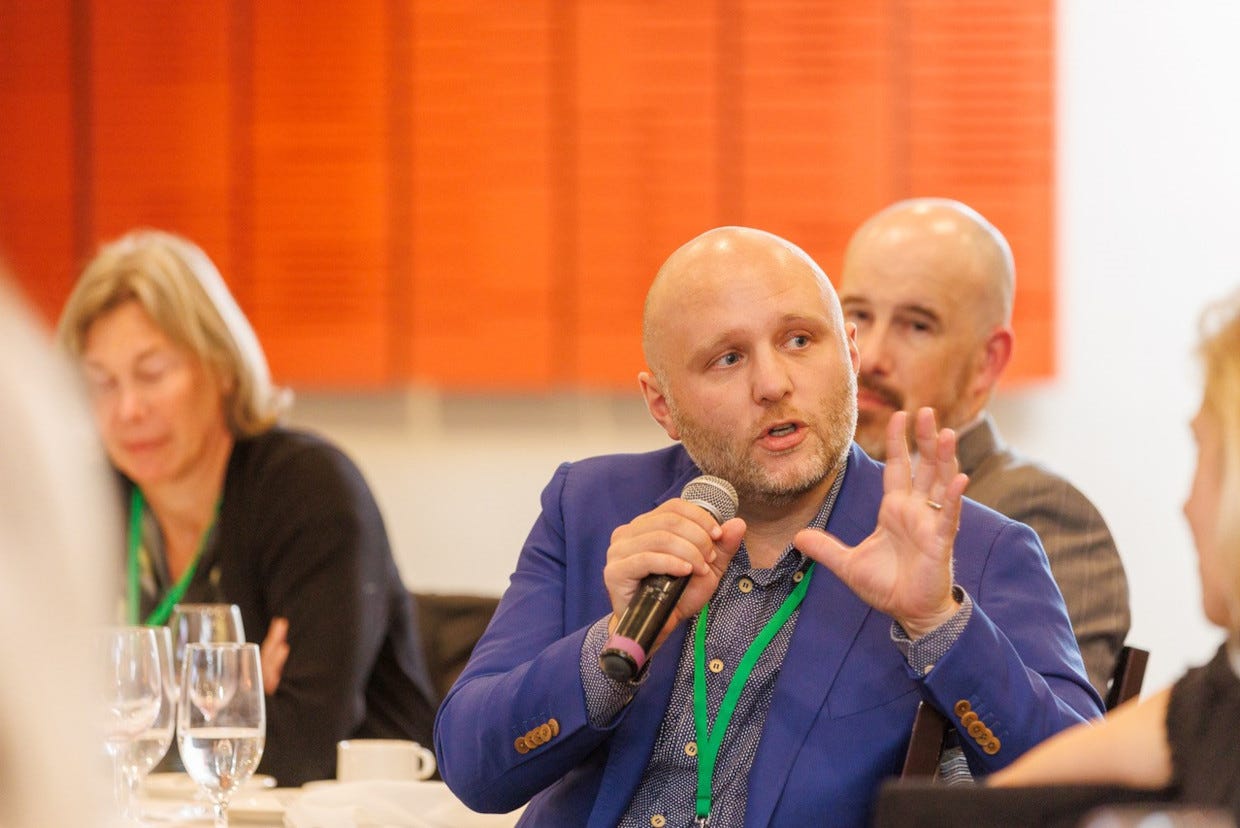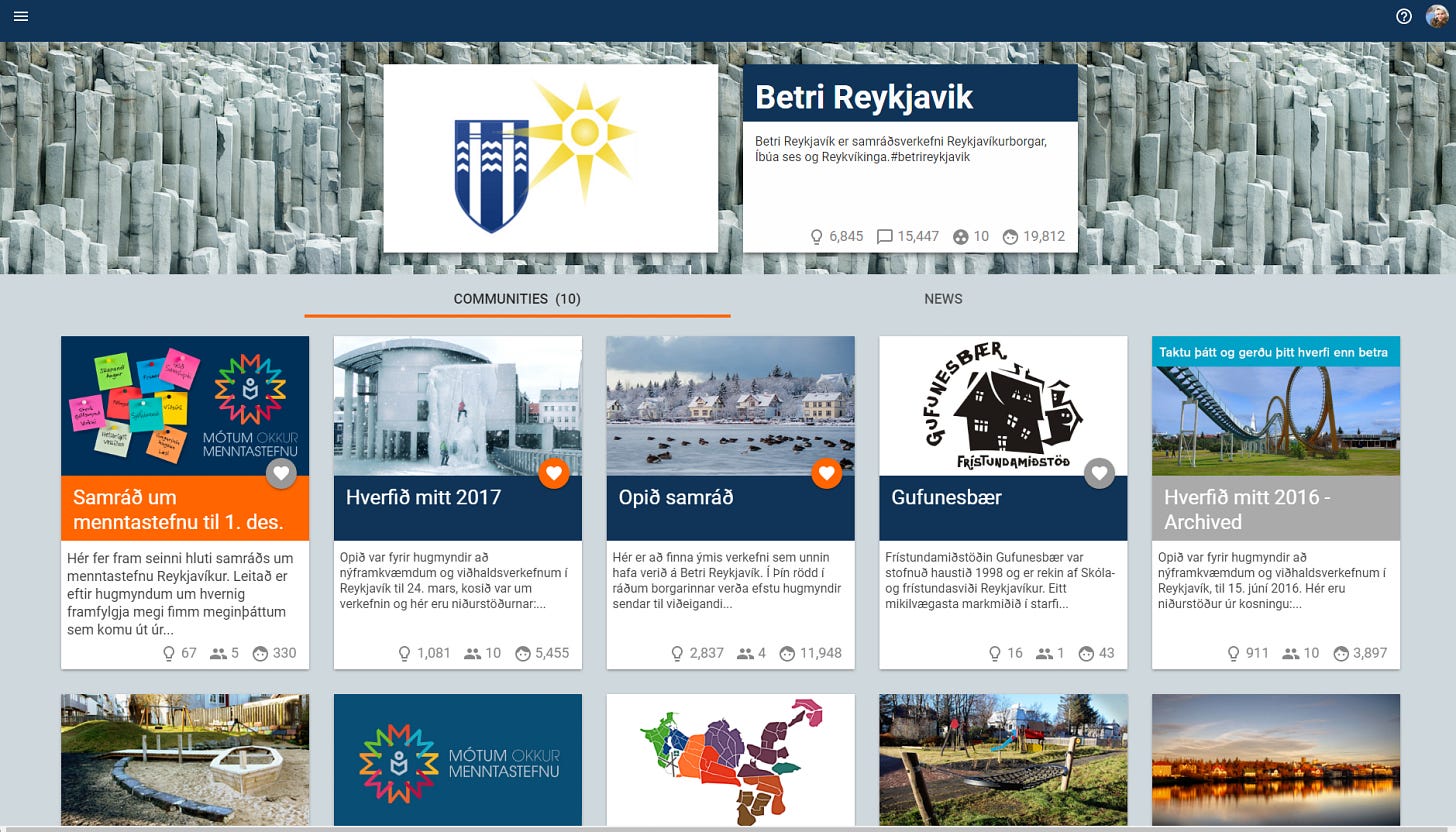A Conversation with Andri Heiðar Kristinsson, CEO at Digital Iceland
Thought Piece #14 On the back of Iceland's meteoric rise up the UN's e-government rankings, Digital Iceland's CEO talks OpenAI, digital readiness and institutional memory...
Andri Kristinsson is not a typical bureaucrat. Before being appointed to lead Digital Iceland, he spent time running a travel start-up, teaching entrepreneurship at Reykjavik university, and doing an MBA at Stanford. Moving from the startup world to government can be a challenge, but talking to Andri it was clear that he had thought long and hard about striking a balance between moving fast and breaking things and building a long-term strategic vision of change.
I was left with the feeling that Iceland’s strength as a digital nation - the country is ranked the 5th most mature in the UN’s e-Government index - is no coincidence. Instead, Iceland’s is a story of learning humbly and learning openly, with a healthy dose of well-timed opportunism.
Despite representing a country of just 370,000 people, Andri Heiðar Kristinsson is a regular name on the agendas of some of the biggest global GovTech conferences. Iceland, as a digital nation, punches well above its weight. The UN’s most recent e-Government index placed it 5th in the world, competing with the likes of Denmark and Finland.
Responsibilities for digital government in Iceland are divided between the Office of Digital Transformation; Ministry of Transportation and Infrastructure; and Digital Iceland. Kristinsson heads up the latter, which works cross-government to build and centralize digital services. Located within the country’s Ministry of Finance, the agency reflects a model that has proved so successful in Estonia and Denmark in solving the challenge of generating cross-government buy-in for digital projects. For Kristinsson, working across different departments is perhaps a natural place to be. With a career spent between academia, entrepreneurship, and some of Silicon Valley’s biggest companies, his experience and skillset are diverse.
A couple of days before we spoke, he had been in Ottawa to talk about the importance (or otherwise) of government developing a formal digital transformation strategy. There he told the audience that when he started his job, he was explicitly told “do not start with a strategy. We want you to start by doing things”. It would take 18 months of moving fast and getting things done until his team finally sat down to write their plans out formally. However, these entrepreneurial instincts are complemented in his clear investment in researching and learning from others in the GovTech space. The first thing he says in our interview is that “in order for organizations to successfully innovate first you need to imitate, to copy, and build on what has already been done well’”.
Kristinsson discusses digital government strategy in Ottawa (Source: Global Government Forum)
The country’s digitalization program has managed to find a happy medium between the two. On the one hand, it has developed a deep relationship with both Estonia and Finland, underpinned by its integration with the X-Road data exchange layer. But it is also opportunistic in and of itself. Following a meeting between OpenAI and the President of Iceland, for example, it was agreed that Icelandic would be included in the language models used to train GPT-4. It was the only other language aside from English to be used in this way. For OpenAI, the complexity of Icelandic is useful for training its large language models. For the Icelandic government, concerned with preserving a language threatened by “digital extinction” in the “age of Facebook, YouTube and Netflix”, this is quite the coup.
Despite this, Kristinsson assures me that AI is not a core part of Digital Iceland’s immediate plans. He talks about digital transformation in the contexts of Maslow’s hierarchy of needs. First there are the foundational layers of internet connectivity and so forth; then data storage; beyond which are digital applications. It is here that Iceland currently sits, and “only in the fourth or fifth layer do you begin to live with blockchain and AI”.
Central to Digital Iceland’s current priorities is building Island.is – a Gov.UK-style centralized website for digital government services - together with a generic purpose companion digital app which will become the homeplace for digital mail and day-to-day government tasks. These products aim to condense dozens of government websites into a single place, serving as the foundation for pre-emptive and proactive government services and allowing the government to benefit from economies of scale. As Kristinsson reminds me, Iceland is a small country with limited resources, but is also expected to build the same number of digital services as countries many times bigger than it.
In building these tools, the agency has been given its own budget to support other departments. Where two departments might once have squabbled over funding a service that benefitted both, Digital Iceland is able to use its own resources to plug the gap. The result is a hybrid and multidisciplinary approach that allows core products to be built on Digital Iceland platforms. Government departments can apply for support from Digital Iceland, which then stands up teams to oversee and deliver specific projects.
Building Institutional Memory into the Digital Iceland Approach
Growing at such a pace (Digital Iceland expects to add dozens more services to Island.Is by the end of the year) prompts two obvious questions. Firstly, how Digital Iceland ensures “digital readiness” of services when they are released, and secondly how institutional memory is embedded into services when the country is moving so fast.
The answer to the first is straightforward: “we don’t necessarily want the services ready” Kristinsson says, preferring instead to release a service as early as possible and iterate it in an agile way. He gives the example of a recent maternity/ paternity application. The service pulls together citizens’ health records, employment, tax contributions and the like to enable them to apply for maternity/ paternity leave. In the first instance, this service was designed and released only for its primary use case – parents who are still together and in full employment. Through constant iteration, it has quickly become applicable to further use cases: single parents, self-employed parents, students etc. By now, 89% of citizens are choosing to apply for paternity/maternity leave online on a platform which is accessible to 97% of the population.
The answer to the second question stems from the first. To build institutional memory, Digital Iceland has been working at a product, systems and cultural level. On the product side, building agile and interoperable systems has proved crucial here too. Echoing the building blocks approach of GovStack and Ireland, several “base layers” of services have been identified by the Digital Iceland team (making a payment, or applying for a document, for example). If an agency wants to produce an application platform, they have the option of either developing a custom application as with the maternity service, using preceding services to create a no-code solution for themselves. This leaves Digital Iceland to focus on “building for the long tail of infrequent use cases”.
Structurally, the approach to creating institutional memory is threefold. Firstly, the government is focused on building a library of digital assets online to communicate best practice; guidelines and existing policies. Secondly, they host an annual conference for public agencies and ministries, which is recorded and published online. Thirdly, a digital training portal inspired by the UK’s GDS Academy is offering formal trainings for public servants on digital.
Finally, there is the cultural factor of the Icelandic commitment to radical transparency. Together with the practical value of avoiding digital lock-in by being open source, Kristinsson talks about the national consciousness of Iceland as a small consensus-based country. This has famously fed in when it comes to digital democracy efforts. Iceland is world-leading in this area, notably with the example of Better Reykjavik, a digital democracy platform for crowdsourcing policy ideas. Added to this are the ideals of public service: “we are spending public money, so we should be open source and allow others to use what we built”.
Better Reykjavik has already become a world-leading example of digital democracy (Source: Citizens Foundation)
In late 2022, the global investment manager Schroders wrote a piece on Iceland’s digital capacity, labelling it “the land of fire, ice … and digital infrastructure?”. If Iceland’s digital prowess is a surprise, it is certainly no mystery. Through a commitment to being open and learning through humility, it has built a world-leading digital government offering. By the time the UN’s next eGovernment index rolls around, it should be no surprise at all to see the country once again contending for the title of most developed digital nation on earth.





